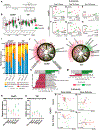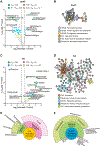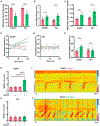Peripheral neuronal activation shapes the microbiome and alters gut physiology
- PMID: 38517896
- PMCID: PMC11132177
- DOI: 10.1016/j.celrep.2024.113953
Peripheral neuronal activation shapes the microbiome and alters gut physiology
Abstract
The gastrointestinal (GI) tract is innervated by intrinsic neurons of the enteric nervous system (ENS) and extrinsic neurons of the central nervous system and peripheral ganglia. The GI tract also harbors a diverse microbiome, but interactions between the ENS and the microbiome remain poorly understood. Here, we activate choline acetyltransferase (ChAT)-expressing or tyrosine hydroxylase (TH)-expressing gut-associated neurons in mice to determine effects on intestinal microbial communities and their metabolites as well as on host physiology. The resulting multi-omics datasets support broad roles for discrete peripheral neuronal subtypes in shaping microbiome structure, including modulating bile acid profiles and fungal colonization. Physiologically, activation of either ChAT+ or TH+ neurons increases fecal output, while only ChAT+ activation results in increased colonic contractility and diarrhea-like fluid secretion. These findings suggest that specific subsets of peripherally activated neurons differentially regulate the gut microbiome and GI physiology in mice without involvement of signals from the brain.
Keywords: Akkermansia muciniphila; CP: Microbiology; CP: Neuroscience; cholinergic; dopaminergic; enteric nervous system; gut microbiome; gut motility; noradrenergic; peripheral nervous system.
Copyright © 2024 The Author(s). Published by Elsevier Inc. All rights reserved.
Conflict of interest statement
Declaration of interests B.B.Y. declares financial interests in Nuanced Health, which is not related to the present study. S.K.M. declares financial interests in Axial Therapeutics and Nuanced Health, which is not related to the present study. P.C.D. is an advisor and holds equity in Cybele and Sirenas and is a scientific co-founder and advisor and holds equity to Ometa, Enveda, and Arome with prior approval by University of California, San Diego. He also consulted for DSM animal health in 2023. R.K. is a scientific advisory board member and consultant for BiomeSense, Inc.; has equity, and receives income. He is a scientific advisory board member of and has equity in GenCirq. He is a consultant and scientific advisory board member for DayTwo and receives income. He has equity in and acts as a consultant for Cybele. He is a co-founder of Biota, Inc. and has equity. He is a cofounder of Micronoma, has equity, and is a scientific advisory board member. The terms of these arrangements have been reviewed and approved by the University of California, San Diego in accordance with its conflict of interest policies.
Figures






References
-
- Furness JB (2008). The Enteric Nervous System (Wiley; ). https://books.google.com/books?id=pvkpdNHhI6cC.
-
- Grundy D, and Brookes S (2011). Neural Control of Gastrointestinal Function (Morgan & Claypool Life Science Publishers; ). https://books.google.com/books?id=NV2BMJk6XHwC.
Publication types
MeSH terms
Substances
Grants and funding
LinkOut - more resources
Full Text Sources
Molecular Biology Databases
Research Materials
Miscellaneous

